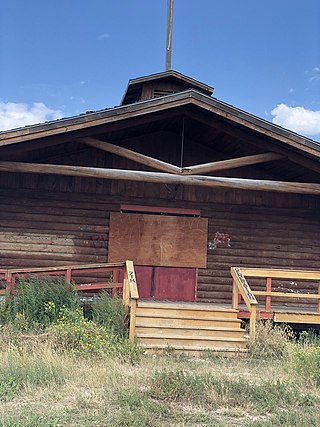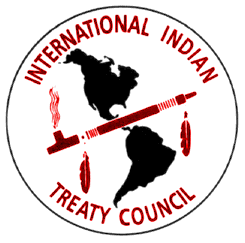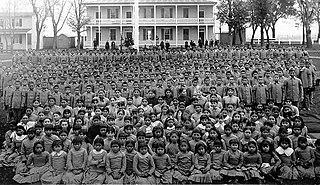
Indian Territory and the Indian Territories are terms that generally described an evolving land area set aside by the United States government for the relocation of Native Americans who held original Indian title to their land as an independent. The concept of an Indian territory was an outcome of the U.S. federal government's 18th- and 19th-century policy of Indian removal. After the American Civil War (1861–1865), the policy of the U.S. government was one of assimilation.
Paul Smith or Paul Smith's may refer to:

Quanah Parker was a war leader of the Kwahadi ("Antelope") band of the Comanche Nation. He was likely born into the Nokoni ("Wanderers") band of Tabby-nocca and grew up among the Kwahadis, the son of Kwahadi Comanche chief Peta Nocona and Cynthia Ann Parker, an Anglo-American who had been abducted as an eight-year-old child during the Fort Parker massacre in 1836 and assimilated into the Nokoni tribe. Following the apprehension of several Kiowa chiefs in 1871, Quanah Parker emerged as a dominant figure in the Red River War, clashing repeatedly with Colonel Ranald S. Mackenzie. With European-Americans hunting American bison, the Comanches' primary sustenance, into near extinction, Quanah Parker eventually surrendered and peaceably led the Kwahadi to the reservation at Fort Sill, Oklahoma.

The American Indian Movement (AIM) is an American Indian grassroots movement which was founded in Minneapolis, Minnesota in July 1968, initially centered in urban areas in order to address systemic issues of poverty, discrimination, and police brutality against American Indians. AIM soon widened its focus from urban issues to many Indigenous Tribal issues that American Indian groups have faced due to settler colonialism in the Americas. These issues have included treaty rights, high rates of unemployment, the lack of American Indian subjects in education, and the preservation of Indigenous cultures.

Dennis J. Banks was a Native American activist, teacher, and author. He was a longtime leader of the American Indian Movement, which he co-founded in Minneapolis, Minnesota in 1968 to represent urban Indians. He was a pre-eminent spokesman for Native Americans. His protests won government concessions and created national attention and sympathy for the oppression and endemic social and economic conditions for Native Americans.

The Institute of American Indian Arts (IAIA) is a public tribal land-grant college in Santa Fe, New Mexico, United States. The college focuses on Native American art. It operates the Museum of Contemporary Native Arts (MoCNA), which is housed in the historic Santa Fe Federal Building, a landmark Pueblo Revival building listed on the National Register of Historic Places as Federal Building. The museum houses the National Collection of Contemporary Indian Art, with more than 7,000 items.

The Wounded Knee Occupation, also known as Second Wounded Knee, began on February 27, 1973, when approximately 200 Oglala Lakota and followers of the American Indian Movement (AIM) seized and occupied the town of Wounded Knee, South Dakota, United States, on the Pine Ridge Indian Reservation. The protest followed the failure of an effort of the Oglala Sioux Civil Rights Organization (OSCRO) to use impeachment to remove tribal president Richard Wilson, whom they accused of corruption and abuse of opponents. Protesters also criticized the United States government's failure to fulfill treaties with Native American people, and demanded the reopening of treaty negotiations with the goal of fair and equitable treatment of Native Americans.

Fritz William Scholder V was a Native American artist, who produced paintings, monotypes, lithographs, and sculptures. Scholder was an enrolled member of the La Jolla Band of Luiseño Indians, a federally recognized tribe of Luiseños, a California Mission tribe. Scholder's most influential works were post-modern in sensibility and somewhat Pop Art in execution as he sought to deconstruct the mythos of the American Indian. A teacher at the Institute of American Indian Arts (IAIA) in Santa Fe in the late 1960s, Scholder instructed prominent Native American students.
George Paul Horse Capture (A'aninin) was an anthropologist, activist, and writer.
Adam Fortunate Eagle L.H.D., hereditary member of the Red Lake Band of Chippewa Indians, is a Native American activist and was the principal organizer of the 1969–1971 Occupation of Alcatraz by "Indians of All Tribes".

The Red Power movement was a social movement which was led by Native American youth who demanded self-determination for Native Americans in the United States. Organizations that were part of the Red Power Movement include the American Indian Movement (AIM) and the National Indian Youth Council (NIYC). This movement advocated the belief that Native Americans should have the right to implement their own policies and programs along with the belief that Native Americans should maintain and control their own land and resources. The Red Power movement took a confrontational and civil disobedience approach in an attempt to incite changes in Native American affairs in the United States compared to using negotiations and settlements, which national Native American groups such as National Congress of American Indians had before. Red Power centered around mass action, militant action, and unified action.

The Occupation of Alcatraz was a 19-month long occupation by 89 American Indians and their supporters of Alcatraz Island and its prison complex, classified as abandoned surplus federal land. The occupation was led by Richard Oakes, LaNada Means, and others, while John Trudell served as spokesman. The group lived on the island together until the occupation was forcibly ended by the U.S. government.
Edward D. Castillo, of the Luiseño-Cahuilla tribes, is a Native American activist who participated in the American Indian occupation of Alcatraz in 1969. Former professor and director of Native American Studies at the Sonoma State University in California, he wrote several chapters in the Smithsonian Institution's Handbook of North American Indians and Mission Indian Federation: Protecting Tribal Sovereignty 1919-1967, published in the Encyclopedia of Native Americans in the 20th century. He is the editor of Native American Perspectives on the Hispanic Colonization of Alta California and The Pomo, A Tribal History. Castillo was a regular contributor of book reviews to historical journals such as Indian Historian, Journal of California Anthropology, Western Historical Quarterly, American Indian Quarterly, and California History.
Gladys Bissonette, "the brave–hearted woman of Wounded Knee", was an Oglala Lakota elder who was one of the leaders of the traditional faction during the violent turmoil on the Pine Ridge Indian Reservation during the 1970s. Dick Wilson became Tribal Chairman in 1972 and began a "reign of terror" on the reservation. Wilson favored mixed–blood residents and close family and friends for positions in his office and created a special enforcing unit, known as the "Goon Squad", to police the region. This Goon Squad soon began to terrorize the residents of the reservation who openly spoke out against Wilson or disagreed with him, especially those who were pure–blooded Indians. Many attempts were made at impeaching Wilson, but Wilson always interfered and subsequently kept his position by sending out his Goon Squad to stamp out the residents who dared try to impeach him. "The past administrations all along have been pretty sly and crooked with Indian funds," said Gladys, "but they weren't quite as hard on us as this drunken fool we got now."

The International Indian Treaty Council (IITC) is an organization of Indigenous Peoples from North, Central, South America, the Caribbean and the Pacific working for the Sovereignty and Self-Determination of Indigenous Peoples and the recognition and protection of Indigenous Rights, Treaties, Traditional Cultures and Sacred Lands.

The Great Sioux Nation: Sitting in Judgment on America is a book edited by Roxanne Dunbar-Ortiz, "An Oral History of the Sioux Nation and Its Struggle for Sovereignty", that documents the 1974 "Lincoln Treaty Hearing". Testimony produced during that hearing has been cited by the International Indian Treaty Council in advocating for Indigenous sovereignty and treaty rights, efforts which eventually saw the 2007 Declaration on the Rights of Indigenous Peoples.
Robert Warrior, is a scholar and Hall Distinguished Professor of American Literature and Culture at the University of Kansas. With Paul Chaat Smith, he co-authored Like a Hurricane: The Indian Movement from Alcatraz to Wounded Knee. He is generally recognized, along with Craig Womack, as being one of the founders of American Indian literary nationalism. Warrior served as president of the American Studies Association from 2016 to 2017.
From 1969 to 1974, the Richard Nixon administration made important changes to United States policy towards Native Americans through legislation and executive action. President Richard Nixon advocated a reversal of the long-standing policy of "termination" that had characterized relations between the U.S. federal government and American Indians in favor of "self-determination." The Alaska Native Claims Settlement Act restructured indigenous governance in Alaska, creating a unique structure of Native Corporations. Some of the most notable instances of American Indian activism occurred under the Nixon Administration, including the Occupation of Alcatraz and the Occupation of Wounded Knee.
Dr. Linda Susan Aranaydo is a Native American physician, educator, and activist. Aranaya recognized the impact that health care inaccessibility had on her community and decided to steer her career toward involvement in public health and family medicine. Among other honors, Aranaydo is the recipient of the 1995 David Vanderryn Award for Outstanding Community Service as a Family Physician.

Both during and after the colonial era in American history, white settlers engaged in prolonged conflicts with Native Americans in the United States, seeking to displace them and seize their lands, resulting in American enslavement and forced assimilation into settler culture. The 19th century witnessed a surge in efforts to forcibly remove certain Native American nations, while those who remained faced systemic racism at the hands of the federal government. Ideologies like Manifest destiny justified the violent expansion westward, leading to the passage of the Indian Removal Act of 1830 and armed clashes.












